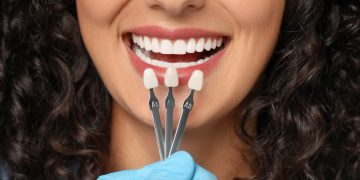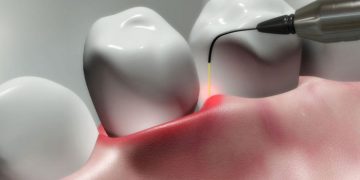Introduction
Cavities, also known as dental caries, are one of the most common dental problems faced by both children and adults. They form when bacteria in the mouth produce acids that erode tooth enamel, leading to tooth decay. While brushing, flossing, and maintaining a healthy diet are important in preventing cavities, fluoride has emerged as one of the most effective treatments for reducing the risk of dental decay.
Fluoride is a naturally occurring mineral that plays a crucial role in dental health. It strengthens tooth enamel, making it more resistant to the acids produced by bacteria in the mouth. Fluoride treatments have been proven to help prevent cavities in both children and adults, with various application methods available depending on age and need. This article explores the effectiveness of fluoride treatments in cavity prevention, detailing how fluoride strengthens enamel, the different treatment options available, and the specific role fluoride plays in both children’s and adults’ oral health.
How Fluoride Strengthens Enamel and Prevents Decay
To understand the impact of fluoride on cavity prevention, it’s important to first explore how it works at a molecular level. Fluoride helps to prevent cavities by remineralizing tooth enamel, the outer layer of the tooth. Enamel is a hard, protective layer that shields the underlying tooth structures from decay. However, enamel is constantly exposed to demineralization, where acids from food and bacteria weaken it over time. If enamel is not remineralized, it can lead to the formation of cavities.
1. Enamel Remineralization
Fluoride aids in the remineralization process by attracting minerals such as calcium and phosphate back into the enamel. When fluoride is present in the mouth, it incorporates into the enamel structure, replacing lost minerals and forming a stronger, more acid-resistant layer. This helps to repair early signs of tooth decay before they turn into full-fledged cavities.
2. Inhibition of Acid Production
Fluoride also helps to inhibit the ability of bacteria in the mouth to produce acids. By interfering with the metabolic processes of bacteria, fluoride reduces the overall acidity in the mouth. Lower acidity levels result in a less favorable environment for decay-causing bacteria, thereby preventing further damage to the enamel.
3. Acid-Resistant Enamel
The enamel that has been strengthened by fluoride is more resistant to future acid attacks. This makes fluoride particularly effective in areas of the mouth that are more susceptible to cavities, such as the back molars, which are harder to clean and often harbor bacteria.
By fortifying the enamel and creating a more resilient barrier against bacteria and acids, fluoride plays a critical role in cavity prevention.
Fluoride Treatment Options (Topical, Systemic)
Fluoride is available in several forms, each designed for different methods of application. There are two primary categories of fluoride treatments: topical and systemic.
1. Topical Fluoride
Topical fluoride treatments are applied directly to the surface of the teeth, where it is absorbed by the enamel. These treatments are commonly used to protect teeth that are already exposed to the oral environment. Topical fluoride comes in various forms, such as toothpaste, mouth rinses, and professional fluoride gels or varnishes.
- Toothpaste and Mouth Rinses: Fluoride toothpaste is the most common and accessible form of fluoride treatment. It is designed for daily use and provides continuous fluoride exposure to the teeth. Fluoride mouth rinses are also available and are often used in addition to brushing to provide extra protection.
- Professional Treatments: Dentists and dental hygienists can apply stronger topical fluoride treatments during regular checkups. These treatments include fluoride gels, foams, and varnishes, which contain a higher concentration of fluoride than over-the-counter products. Professional fluoride treatments are particularly beneficial for individuals who are at higher risk of cavities, such as those with orthodontic appliances or a history of frequent cavities.
2. Systemic Fluoride
Systemic fluoride is ingested and absorbed into the bloodstream, where it is carried throughout the body. This type of fluoride is then incorporated into the developing teeth, making them stronger and more resistant to decay. Systemic fluoride can be delivered in several ways:
- Fluoridated Water: The most common form of systemic fluoride comes from drinking water that has been fluoridated. Many public water systems around the world add fluoride to their water supplies in order to promote oral health. People who drink fluoridated water receive a small but consistent dose of fluoride, which helps to strengthen developing teeth.
- Fluoride Supplements: For individuals who do not have access to fluoridated water, fluoride supplements may be prescribed by a dentist or pediatrician. These supplements are typically available in the form of tablets, drops, or lozenges and are usually given to children at high risk for cavities.
- Food and Beverages: Fluoride can also be found naturally in certain foods and beverages, such as tea, fish, and certain fruits and vegetables. However, these sources typically provide smaller amounts of fluoride compared to drinking water or supplements.

The Role of Fluoride in Cavity Prevention for Kids vs. Adults
Fluoride plays a vital role in cavity prevention for both children and adults, but the way it benefits each group can differ. Children and adults have different oral health needs, and fluoride treatments are tailored to address these differences.
1. Fluoride and Children’s Oral Health
Fluoride is especially important for children because their teeth are still developing and are more vulnerable to decay. Fluoride helps to strengthen their developing tooth enamel and makes their teeth more resistant to cavities. Starting fluoride treatments early, especially in communities with non-fluoridated water, can help reduce the likelihood of childhood cavities.
In addition to strengthening enamel, fluoride also plays a role in the prevention of early childhood cavities, commonly known as “baby bottle tooth decay.” This condition occurs when babies or toddlers are frequently exposed to sugary liquids in bottles or sippy cups, which can contribute to tooth decay. Fluoride treatments and proper oral hygiene can help prevent this condition.
For children with braces, fluoride treatments can be crucial in preventing cavities in areas where it is difficult to clean. Braces can trap food and plaque, making it easier for bacteria to cause decay. Regular fluoride treatments help protect these vulnerable spots, preventing the formation of cavities around brackets and wires.
2. Fluoride and Adults’ Oral Health
Fluoride is also important for adults, particularly for those who are at a higher risk of developing cavities. Adults can be more susceptible to tooth decay due to factors such as dry mouth (which can be caused by medications), gum recession, or weakened enamel from previous dental treatments.
For adults, fluoride treatments can help prevent the progression of early cavities, strengthen weakened enamel, and reduce tooth sensitivity. Professional fluoride treatments are often recommended for adults who have a history of cavities or who are undergoing certain dental procedures, such as root planing or treatments for periodontal disease.
Fluoride is also helpful for older adults who may experience bone loss and gum recession. As gums recede, the roots of teeth become exposed, making them more susceptible to decay. Fluoride can help to strengthen the exposed roots and prevent cavities from developing.
Conclusion
Fluoride is an essential tool in the prevention of cavities for both children and adults. It works by remineralizing tooth enamel, reducing the acidity in the mouth, and strengthening teeth to resist decay. Fluoride treatments come in various forms, including topical applications like toothpaste, mouth rinses, and professional treatments, as well as systemic options like fluoridated water and supplements.
For children, fluoride helps protect developing teeth from early decay and plays a key role in preventing conditions like baby bottle tooth decay. In adults, fluoride can prevent the progression of cavities, reduce tooth sensitivity, and strengthen weakened enamel. No matter your age, fluoride treatments can be a simple yet effective way to maintain healthy teeth and prevent the formation of cavities.
If you are concerned about cavities or the best way to incorporate fluoride into your dental care routine, it is always a good idea to consult with your dentist. With the right fluoride treatments and consistent oral care, you can keep your teeth strong and cavity-free for years to come.













































Discussion about this post